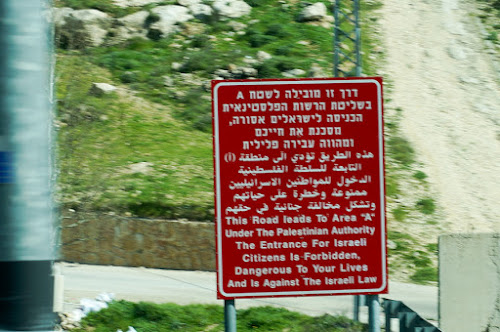Banksy street art in Bethlehem...A site for Christian tourists and pilgrims and only a little over four miles away from Jerusalem, Bethlehem is part of Palestine and is governed by the Palestinian authority.
Another piece of street art by Banksy
Here is the wall keeping the Palestinians inside the city of Bethlehem and out of the rest of Israel. While traveling in Israel and the occupied territories of Palestine, I learned a lot about the entire Israel-Palestine conflict and more about the history of the region and the state of Israel. The situation is really complicated, too complicated to want to profess a strong opinion here on my photo blog. The plight of the Palestinian citizens is deplorable as they are not free humans and I hate that my government ('Murica) assists the Israeli military with cash (an annual package of 3 Billion dollars). However, other than that, I am not going to suggest a solution or criticize either side too much as the more I understand, the more I realize how much tragedy has already occurred and how difficult it will be to resolve.
But I'll add two things. Reading Sandy Tolan's book, The Lemon Tree, helped me to comprehend better the context of the crazy quagmire that is now Israel. And I was surprised to hear from several Palestinians that they support a one-state solution to their conflict. That implication means that despite 135 countries of the United Nations (about 70%of the UN) recognizing the State of Palestine as a sovereign nation, at least some Palestinians would prefer for all of Palestine to be absorbed into Israel (it practically is already since it is all more or less occupied) and be given Israeli citizenship and the right to be free and to travel freely. I imagine this one-state solution is preferable for some Palestinians as they would have the ability to work in Israeli society, which has one of the strongest economies of the region and would be more of a fast-track to modern "normalcy" of being able to work and live as free global citizens. If you have thoughts on this, feel free to write in the comments below...
Touching the spot in the Church of the Nativity where Jesus Christ was supposedly born
In the underground chapel (formerly cave) of Jesus's supposed birthplace with other foreign tourists
Here's a sign in Hebrew, Arabic and English noting the border of a Palestinian Area A. The city of Bethlehem, for example, is an Area A of Palestine. The cities of Palestine Area A are all or mostly enclosed by walls. Israelis are technically not supposed to enter, but no one controls their movements. For Palestinian residents of Area A, most of them cannot leave. It is possible to get permits for day passes (for example to drive a few miles to go work in Jerusalem), but Palestinians must travel through check points to enter into Israel. There are also Palestinian Areas B and C. As a foreign tourist, I can travel freely through all, (though not to Gaza, which is a totally different situation). Actually, this subject is so complicated and the issue of Jerusalem even more so, I'm just going to give you links for anyone who really wants to understand the current "borders" of occupied Palestine:
Wikipedia's explanation of West Bank Areas with maps
Al Jazeera's map of the "occupation" of the West Bank with an explanation of what each Area means and a map of Jerusalem
Wikipedia's explanation of West Bank Areas with maps
Al Jazeera's map of the "occupation" of the West Bank with an explanation of what each Area means and a map of Jerusalem
Waiting at a checkpoint to reenter Israel. Foreigners and Israelis are just waved through.
Also a few miles outside of Jerusalem is Herodion, the ruins of an ancient hilltop fortified palace built by King Herod. Here, workers excavate some of the underground tunnels beneath Herodion.
An ancient cistern of Herodion










1 comment:
Agreed!
Post a Comment